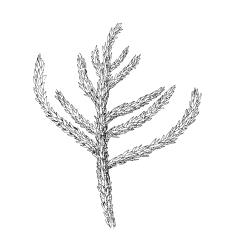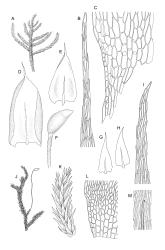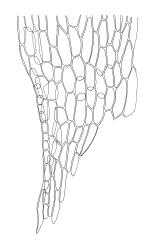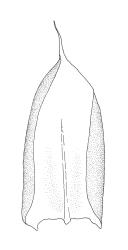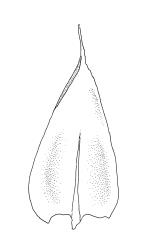Brachythecium subplicatum sensu Sainsbury 1955
Plants robust, soft, bright yellowish-green, shiny, stoloniferous, forming loose, emergent turves. Stems stoloniferous below, with terminal portions erect-ascendant, simple or irregularly branched and often giving rise to elongate, ascendant branches below, green, to 200 mm long, julaceous, in cross-section with a distinct central strand and with 3–5 layers of thick-walled cortical cells, with rhizoids absent or nearly so. Branches variable in length, to 90 mm, terete when moist. Stem leaves imbricate, erect-spreading, little altering and weakly striolate when dry, ovate-oblong, abruptly tapered from a rounded apex to a long (525–725 µm), piliferous, denticulate or entire acumen, with margins plane or somewhat inrolled, strongly concave, decurrent, entire below, usually denticulate above and often with a few large teeth just below the base of the acumen, (2.5–)2.8–3.1 × (1.3–)1.5(–1.7) mm (including acumen). Branch leaves smaller, to c. 2.5 mm long, but otherwise similar. Costa rather weak, c. 30–45 µm wide (⅓ above base), extending ⅔–¾ the length of the leaf (excluding the acumen), lacking a terminal spine. Upper laminal cells smooth, firm-walled, linear, (60–)80–100(–120) × c. 7–8 µm; basal cells shorter, broader, and porose; alar cells ± oblong, moderately enlarged to form a weakly defined, decurrent, non-auriculate group, with a single row of 6–8 shortly rectangular cells often at alar margins.
Autoicous, with inflorescences scattered on stems. Perichaetial leaves oblong to ovate-lanceolate, ecostate, becoming patent above. Perigonia gemmiform, c. 1.5 mm long, with bracts ovate-acuminate, ecostate, and erect, enclosing filiform, 4–5-celled paraphyses. Setae (14–)18–26 mm, smooth, weakly sinistrorse above, red-brown; capsules ± horizontal, curved, oblong-obovoid, c. 2.6 mm, dark yellow-brown; exothecial cells mostly oblong, (30–)36–45(–51) µm long. Annulus not seen; operculum short conic. Exostome teeth lanceolate; endostome with well-developed, nodose, paired cilia. Spores green, 18–22 µm diam., nearly smooth.
In a regional context, this is an unmistakeable species characterised by ovate-oblong and non-plicate leaves abruptly tapered to a long piliferous apex; its semi-aquatic habitat provides further distinction. It is probably most closely allied to B. rutabulum.
Brachythecium fontanum exhibits similarities to B. subplicatum (Hampe) A.Jaeger from the Falkland Is, South Georgia, and magellanic regions of South America, but differs from that species by having more weakly differentiated and non-auriculate alar groups and by being more piliferous, as well as by its geographic distribution.
SI: Nelson, Marlborough (Branch River), Canterbury, Westland, Otago, Southland.
Endemic. The absence of records of this species from both the North I. and other cool regions of Australasia is surprising. Brachythecium latinervium Hedenäs of mainland Australia may prove to be conspecific, but no material of it has been seen.
On water-logged muck or floating in pools associated with montane to subalpine springs, seeps, and stream margins. Usually forming emergent loose turves and sometimes also occurring in waterlogged herb/bryophyte mats in waterfall spray zones. Ranging from 530 m (Eyre Mountains, Southland L.D.) to at least 1680 m (Branch River, Marlborough L.D.). Brachythecium rutabulum, Breutelia pendula, Cratoneuropsis relaxa, Philonotis pyriformis, and Marchantia berteroana are often associated.



